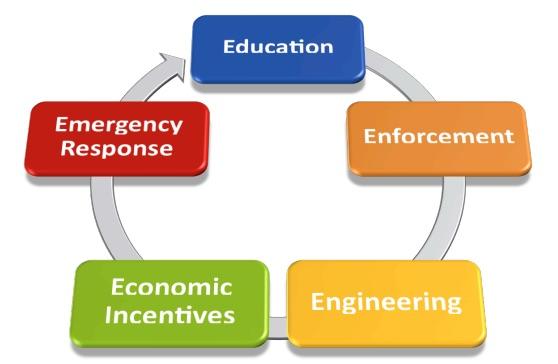The 5 Strategies of CRR: Summer Newsletter Updates 2022
Written by: Chuck Altvater, Fire & Life Safety Section, Professional Development Unit Chief
Community Risk Reduction uses five strategies to address the risks identified in a department’s Community Risk Assessment (CRA). These strategies, known as the “5 E’s,” are:
- Economic Incentives are rewards, and monetary benefits community members realize by reducing the risk they can affect. Some examples of Economic Incentives are tax reductions, insurance premium reductions, or in some cases, the ability to be insured at all, and even operational cost savings by adopting new technologies.
- Education provides information to the public, first responders, and allied agencies. It often fails when not combined with other strategies for reducing community risk. The education practitioners in a fire department, including Fire and Life Safety Educators, Youth Firesetting Interventionists, and Firefighters, need the training to deliver risk reduction messages in the best way for different audiences.
- Enforcement is the adoption and application of codes that, when followed, will reduce risk to people in the built environment, including the Wildland-Urban Interface. When Building, Fire, and other departments implement a permitting process, conduct professional plan reviews for new projects, and conduct regular inspections of existing properties subject to the code, they ensure compliance with lifesaving requirements. The most effective enforcement programs use an educational approach with occupancy owners to ensure they understand the reason for code requirements, feel they can ask questions, and work with the enforcement officials to comply with the code. Fines and closures are sometimes required to gain compliance when faced with intentional, chronic, or gross non-compliance by owners.
- Engineering includes all approaches to reducing the risk involving human beings changing the environment to make it safer. Examples include The installation of fire sprinklers in commercial and residential buildings, The installation of smoke, carbon monoxide, and other gas detectors, and installing devices that help prevent stove or microwave oven fires. Not every engineering response to risk is high-tech. Other examples include using guard rails where a fall risk exists, the reduction of slip and trip hazards in homes and businesses, and the reduction of vegetative fuels around buildings in the Wildland-Urban Interface.
- Emergency Response is the most visible portion of a department’s Community Risk Reduction program. Whether caused by nature or human causes, emergencies will still occur despite a department’s best risk reduction efforts. By anticipating the risks within the community, the department can ensure the appropriate apparatus and trained personnel are stationed to provide the best possible response.
The only way to effectively employ these five strategies is to have a clear, data-based understanding of a community's risks and develop a Community Risk Reduction Plan with stakeholders and partners. No one strategy works well on its own, and multiple approaches must be employed to prevent or reduce potential emergencies resulting from any particular risk.
An excellent example of multiple strategies is mitigating risk from Wildland-Urban Interface fires. WUI Risk Reduction uses all five of these strategies:
- Economic Incentives from AHJs and insurance carriers
- Education of property owners and tenants
- Enforcement of Building and Fire Code
- Engineering in the form of building hardening and fuels management
- Emergency Response is acquiring and positioning firefighting forces, training first responders from all agencies in WUI response, working together to prevent WUI fire ignition or spread, and reducing the effects of those that do occur.
Only by understanding the effectiveness of your programs through evaluation of the process can you know how your CRR were effective and how you can improve them. Conduct hot washes and surveys or other methods of evaluating your programs at each step to ensure you are effective in your effort.
